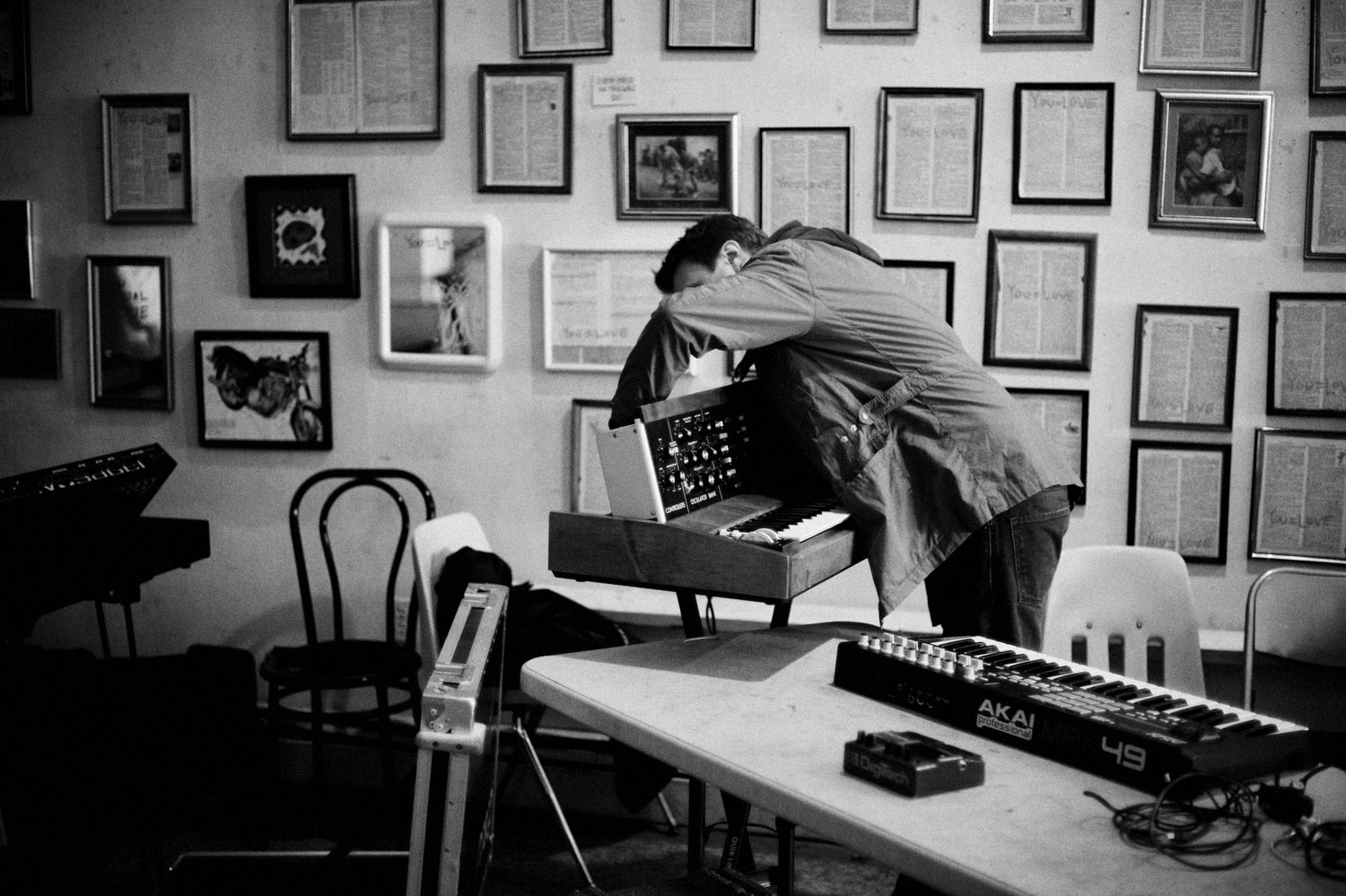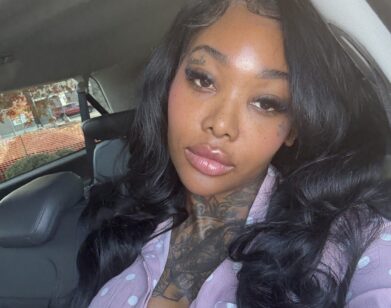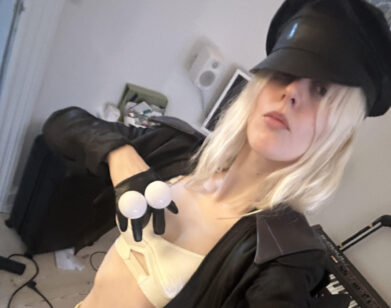O, Pioneers! An Evening with the FRKWYS 7 Ensemble
On the perfectly mown lawn that rolls from the steps of Kresge Theater, part of the Carnegie Mellon University in Pittsburgh, a mutt with wolverine good looks is playing fetch with his owner. He throws himself into the air over and over, each gravity-defying leap more ludicrous than the next. The sun is shining and a peacefulness pervades the grounds of this world-renowned hub for music and technology.
Inside the theater, it’s a different story: a dozen or so students are busy lugging equipment to and from the stage; a handful more stand on a mesh ceiling above the hall testing out the lighting. A hazer chugs out a fine mist into the room, a test to make sure the fire alarm doesn’t go off this evening. Kresge Theater is preparing for the premier performance of the FRKWYS 7 Ensemble as part of Pittsburgh’s VIA music and new media festival. The group includes David Borden (the founder of the world’s first synthesizer ensemble, Mother Mallard’s Portable Masterpiece), and contemporary synth musicians Daniel Lopatin (Oneohtrix Point Never), Laurel Halo, James Ferraro, and Samuel Godin. Aside from rehearsing the day before, the five artists haven’t all been together since the recording of their sublime improvised record for RVNG Intl.’s FRKWYS series recorded last summer and released in July of this year.
A little after 6 pm, with an audience of 150 or so settling into their seats, the lights go down, and David Borden climbs the stairs, a touch shakily, to give a short but warm-hearted lecture about his time with his friend Bob Moog, who invented that famous synthesizer in the mid-’60s. And then it’s time. Lopatin, Halo, Ferraro and Godin join Borden on stage to take their places in the semi-circle of synths, laptops, and various equipment. As much a naturally evolving conversation between the machines they command as a dialogue between the artists, the deeply affecting performance spans the breadth of human emotion, and lingers long after the final synth sigh has faded away. After packing up, the five artists sit down in the theater seats to talk about their instruments and reflect on the experience. —Ruth Saxelby
SHAWN BRACKBILL: What attracted you to the synthesizer as an instrument that you wanted to use? What sort of musical inspiration brought you there?
DAVID BORDEN: Mine was just personal. Bob Moog showed me the thing and I thought, “This is the strangest stuff I’ve ever seen.” Because no one knew what synthesizers were—hardly anybody—in the mid-’60s. I was just fascinated to see if I could overcome my stupidity of not understanding and just try to play it.
DANIEL LOPATIN: I had one in my house as a young kid, and it just looked like a spaceship. [laughter] It just looked like the coolest thing in the house. It was in the basement, and it was mysterious and fun to play with. So I was really lucky in that sense.
RUTH SAXELBY: Who owned it, Dan?
LOPATIN: It was my dad’s stuff, because he was in, like, Russian bar bands.
SAXELBY: Oh, wow.
LOPATIN: So he had some stuff.
BRACKBILL: So had you heard music played on it?
LOPATIN: Just my dad. He had accordion sounds and organ sounds. I didn’t really know what potential it had, but it looked like the cockpit of a helicopter or something.
SAMUEL GODIN: Well, I started out playing piano, first of all. So I had taken piano lessons—classical piano lessons—for a pretty long time and got into playing some rock, and then jazz. So piano was my instrument for a pretty long time before I ever got a synthesizer. And the first one I ever got was an Ensonic ESQ-1. I really wanted to get it both for having possibilities of new sounds, and also because it had a little built-in sequencer, so I could layer tracks. I listened to a lot of different music from Run DMC to, you know, Yaz—just all sorts of stuff that I knew was done by sequencing. And that’s what I could afford at the time, so that was my switch into synths.
SAXELBY: How about you, Laurel?
LAUREL HALO: Well, like Sam, I grew up playing piano, and it was the one instrument I could dive into given my skills playing keyboard. It sounds a lot more exciting than a piano or a digital piano. It’s basically kind of the electric-guitar equivalent. I got into synthesizers not because of one particular album or sound or band, but just beacause I would hear the same synthesizer sounds and arpeggios and, sort of, motifs appear in all different kinds of music, and it kind of made itself apparent as this sonic glue across a lot of different types of sounds. That’s why it was so fascinating to me.
JAMES FERRARO: I definitely was always sort of interested in finding a means to create new sounds, and just to go deeper in tone design and stuff. I’m still learning and exploring synthesizers and other modes of doing that, but it’s definitely one way that introduced me to the idea of working with them, just generating newer sounds and exploring sound.
BRACKBILL: So how did this whole project came about?
LOPATIN: Well, the back story is Matt [from RVNG Intl.] and his FRKWYS idea to bridge the generation gap between like-minded artists, and he had asked me if I had interest in doing it. And I did, but I didn’t really know how to approach it, because I was nervous, because I have this reverence for musicians who actually know how to play, and I don’t. So it was difficult for me. But then, of course, I did the dumbest thing possible: asking David, who can totally play. [laughs] I remember padding the email, being like, “Well, David, you have to understand, I don’t really play music.” [laughs] I’m just, like, warning you that I couldn’t hold it down [on] a real musicianship level. But I had heard your record The Continuing Story Of Counterpoint on this blog called Mutant Sounds, and I was obsessed with it. I was obsessed with the track “Enfield.” It was really a very sparse and very kind of a cold place. That track just felt like a place, and Enfield was the name of the part of the college where I lived. It just affected me in some weird way. It just felt like winter decided to—
BORDEN: Well, it’s called “Enfield in Winter.”
LOPATIN: Yeah, that explains it. [laughs] It sounds like that, for sure.
BRACKBILL: What’s the story behind that track?
BORDEN: It was Judy Borsher [Mother Mallard’s Portable Masterpiece]’s birthday in, I think it was 1977 or something, and we were having the worst snow and cold in the history of Ithaca and its area. We lived in Enfield at this farm house—I mean, that’s where we rehearsed and it was more difficult for them to come every day, because they had to fight the snow. Her birthday’s on January 22, so I gave it to her as a birthday present. I remember the engineer who used to help us—a student at Cornell—I played it for him and said, “Does that sound like winter?” He said, “Oh yeah, that sounds like winter.” [laughs]
LOPATIN: It really does. Also, I had read that your tracks are played through and not sequenced.
BORDEN: Oh right, yeah. That’s right.
LOPATIN: It was just kind of touching, because a lot of the music from the ’70s that people still kind of attach a lot of value to, like the German stuff, is sequencer-based music. But what David did, in a way, felt more like a band, or just felt more—obviously there’s a human element if you’re playing it, but—
HALO: It’s more of a lineage to contemporary classical music as well, because of that. It’s not just like a—well, there’s lots of looping in their minimalist music, but the fact that it is played as opposed to just sequenced gives it a different dimension.
LOPATIN: It sounds a lot edgier today, I think, than the Komische records sound. They sound like canned music. I don’t really vibe with a lot of those records.
SAXELBY: One thing that it would be good to understand is what you all play.
LOPATIN: We kind of divide it up like a band, in a way.
SAXELBY: Right.
HALO: Synthesizer band.
BRACKBILL: Synthesizer jam band.
FERRARO: For me, it was different when we were recording from tonight. In this performance, I was mainly doing percussive things and working with loops and taking elements in and out, stuff like that. I can’t remember what I was actually using during the recording, a couple of different synthesizers…
LOPATIN: An AKAI.
FERRARO: Yeah, AKAI.
LOPATIN: It was cool tonight. Sam was definitely the bass player, almost in a rock sense.
GODIN: At least for a few tracks.
LOPATIN: Laurel was doing a lot of different things, kind of rhythm guitar.
HALO: You were playing upper Eno?
LOPATIN: Yeah, I always play flute and cello. That’s what I do.
HALO: I was just doing a lot of vocal loops, synth loops, layering stuff for color. I was also running effects through different synth channels.
GODIN: I think a lot about playing together the way that we do, which is pretty much all improvised, is having to constantly listen for any open sonic range that might be available at any given moment and decide when a good time to fill it would be, before somebody else does, or maybe while someone else does, and have things weave in and out in the most natural way. There is kind of that element where we are all playing a role, or at least a default role, but there is also just complete openness at the same time.
HALO: I think the most exciting thing about tonight’s performance is that all the pieces would have this gradual ascension to begin, and descent to end, and then there were all these fake-out endings because it would almost end and someone would just throw out an idea, whether it was kind of slowly creeping back up, or a loud jarring thing [snaps her fingers] just to break that descent and keep going. I thought that riding these waves was an enjoyable odyssey.
LOPATIN: Jazz odyssey. [laughter]
BRACKBILL: Synth jam-band odyssey.
LOPATIN: You know that Jazz Odyssey with the band in Spinal Tap? There are like, five people in the audience and they’re going prog or whatever—that’s how it feels sometimes.
GODIN: I didn’t particularly like being introduced as a jazz band, or as a…
LOPATIN: Jam band?
GODIN: Jam band. [laughs]
LOPATIN: Yeah, that was pretty weird. Well David had said “electronic jam group” and I thought that was so cool. “Oh yeah! Duh.”
HALO: But it’s not really a band in the sense that we don’t experience any of those nasty power politics.
LOPATIN: Jam band has…
GODIN: Connotations.
LOPATIN: Yeah. We could’ve swung it at a jam-band festival, though.
HALO: Yeah, people having picnics in the sunshine.
BRACKBILL: It would have been different outside in the daylight.
LOPATIN: A little wilder.
HALO: We probably would have played for four hours.
BORDEN: Your Minimoog wouldn’t have taken to the sunlight.
SAXELBY: I was thinking at the beginning that that was some sort of humidifier on stage that was going to make sure that the equipment wasn’t going to…
BORDIN: Yeah, that’s what I thought too.
SAXELBY: I was like, “Wow, they’re really preparing the stage.”
LOPATIN: High stakes.
GODIN: It’s true. The Minimoog, the one that I have, is the original series, and it really is sensitive to a lot of things. It has a very human element in some ways. You literally have to turn it on and wait for about 30 minutes until it’s really warmed up enough and won’t go out of tune. It’s slightly unpredictable. That’s just the nature of playing on the instrument.
BORDEN: It doesn’t have memory, either; he has to dial up every new sound.
GODIN: Exactly. Or morph it into another sound.
BORDEN: We are talking about the early electronic studio days, the days when sounds didn’t have names. [laughter]
HALO: How do you feel about there being this proliferation of soft-synths, and really easily customizable synths versus the days of patching for minutes between different pieces?
BORDEN: No, I like it the way it is now. I really do. I wouldn’t change it for anything. I seldom use a patch at face value, I always change a few things before I do—you probably do too. But I’m glad that I don’t have to re-invent the wheel every time I go to a studio.
LOPATIN: Dude, some of our colleagues in experimental synth music are really almost gung-ho about the modular stuff, still, to this day. Do you know this company Doepfer?
BORDEN: No, I don’t think so.
LOPATIN: There are a lot of modular synth nuts. I’ve seen so many shows recently where people bring a little suitcase of modular stuff.
HALO: And recently there have been lots of small synth companies developing in the US for modular synths, where you pay a yearly fee and they give you this extended modular rental and then you can either pay the full amount and keep the synth at the end or you can give it back.
FERRARO: Do you think that there is a practical reason for using that gear, or do you think it’s sort of a fetish?
LOPATIN: For some people, it’s very serious for them because they are building out their system and they have very specific ideas about what sounds they want to be able to match up, or they want to find new things that haven’t been heard yet with combinations of these things.
BORDEN: Does the name “Joe Paradiso” ring a bell? You should Google him; he has the world’s largest modular synthesizer, and he built most of it himself. He’s a professor at MIT, an old Mother Mallard fan. He had it in his basement for years and then he moved it into MIT, into a room that they weren’t using, and it’s on a patch that’s constantly being sequenced, it never repeats itself [laughs]. You can tune in anytime and hear it: “Blehhhhh.”
LOPATIN: That’s incredible.
BORDEN: You know, it will be doing, “Deh deh deh deh,” it will be doing something else. He just puts it on random.
FERRARO: I like his name: Joe Paradiso.
BRACKBILL: You were talking about the way you guys approached the live performance, and I was curious about how that was different from how you initially approached the recording process of the record.
FERRARO: It’s like what you were saying earlier, Sam, how there is really not that much dialogue…
GODIN: Right—I realized right after we got offstage—it was the first time that we’d played more than 10 minutes, ever, without stopping and talking about something.
HALO: The recording process was also a lot of jamming.
GODIN: There’d always be that stopping in between takes and discussing, “How can we do this differently?” or whatever. When we were rehearsing yesterday, which was the first time we ever really rehearsed, we could talk about stuff, but this was the first live experience where we really just had to go with it.
BORDEN: This was the first time we had done it in front of an audience, wasn’t it? Except for ourselves. [laughter]
BRACKBILL: So the pieces on the record came out of jamming?
HALO: We’d talk about vague ideas or say, “Let’s try a song with vocal, and let’s do something on that,” or, “Let’s try something on this loop or this sample.” But it was pretty organic, there wasn’t too much, “We have to go for this sound on this track.” There was a lot of playing and figuring each other out, figuring out what each person is good at and how to coalesce. We recorded what, 15 hours of music? And kept 40 minutes of it.
SAXELBY: I want the director’s cut.







